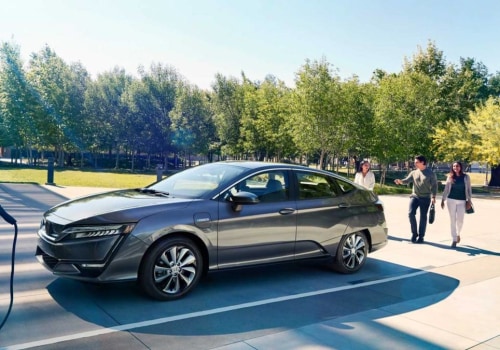In an ever-changing world, electric vehicles are becoming increasingly popular. With the rise of environmental awareness, the convenience of electric vehicles, and the advancement of technology, more and more people are turning to electric vehicles as their preferred mode of transportation. But what exactly are electric vehicles, and what types are available? This article will explore the various types of electric vehicles available on the market today, from passenger cars to commercial trucks. Electric vehicles operate through the use of batteries that store and generate electricity. These vehicles have the potential to reduce emissions and help protect the environment, as they do not produce any exhaust fumes.
Electric vehicles can also be cheaper to run than traditional petrol or diesel vehicles, due to lower running costs and increased efficiency. This article will discuss the different types of electric vehicles available today, from passenger cars to commercial trucks. We'll also look at some of the advantages and disadvantages of electric vehicles, and how they compare to other forms of transport. The most common type of electric vehicle is an all-electric vehicle (EV). This type of electric vehicle has an electric motor that powers the wheels and does not use any fuel. Depending on the model, some EVs have a range of up to 300 miles on a single charge.
EVs also come in different sizes and styles, from small two-seaters to large SUVs. The main advantages of EVs are their low running costs and minimal environmental impact. Another type of electric vehicle is a hybrid electric vehicle (HEV). This type of vehicle combines a traditional internal combustion engine (ICE) with an electric motor. The ICE powers the car most of the time, but the electric motor kicks in when extra power is needed, such as when accelerating or climbing hills.
HEVs tend to have higher fuel economy than traditional ICE vehicles and emit lower levels of greenhouse gases.Plug-in hybrid electric vehicles (PHEVs) are similar to HEVs but have larger batteries that allow them to run solely on electricity for short distances. This makes them ideal for city driving, as they can be recharged at home or at public charging stations. PHEVs also tend to have higher fuel economy than traditional ICE vehicles and emit lower levels of greenhouse gases.Finally, hydrogen fuel cell electric vehicles (FCEVs) are powered by a combination of hydrogen and oxygen. The hydrogen is stored in a tank and reacts with oxygen in the air to produce electricity, which powers the vehicle's motor.
FCEVs are still relatively rare compared to other types of electric vehicles, but they offer longer range and faster refueling times than other types of EVs. When purchasing an electric vehicle, there are several factors to consider. First, you should evaluate your driving needs and lifestyle to determine which type of electric vehicle is best suited for you. You should also consider the cost of purchasing and maintaining the vehicle, as well as any incentives available from your local government or utility provider. Additionally, you should research charging station availability in your area to ensure you can easily recharge your electric vehicle.
Hydrogen Fuel Cell Electric Vehicles (FCEVs)
Hydrogen fuel cell electric vehicles (FCEVs) are a type of electric vehicle that run on a combination of hydrogen and oxygen stored in a tank.Unlike other types of EVs, FCEVs have the ability to offer longer range and faster refueling times. FCEVs use an electrolysis process to split hydrogen molecules into hydrogen and oxygen, which is then used to create electricity. The electricity is then used to power the vehicle's electric motor. This system is highly efficient, with only water being emitted from the tailpipe.
One of the biggest advantages of FCEVs is their long driving range. While battery-powered EVs have a range of around 200 miles, FCEVs can travel up to 300 miles on a single tank of hydrogen. Additionally, refueling an FCEV takes about five minutes compared to the hours it takes to charge a battery-powered EV. However, FCEVs also have some drawbacks.
For one, they are much more expensive than other types of EVs, and there are still very few hydrogen fuel stations in the US. Additionally, FCEVs are still relatively new technology and may not be as reliable as other types of EVs. Overall, FCEVs offer an intriguing alternative for those looking for longer driving range and faster refueling times. However, they come with some drawbacks that should be considered before making a purchase.
Plug-in Hybrid Electric Vehicles (PHEVs)
Plug-in hybrid electric vehicles (PHEVs) are an increasingly popular type of electric vehicle.With larger batteries than regular hybrids, PHEVs can run solely on electricity for short distances, making them ideal for city driving. PHEVs can be recharged either at home or at public charging stations, and their larger battery size makes them more efficient than regular hybrids. When it comes to the actual purchase of a PHEV, there are a few key factors to consider. First, you'll want to make sure the car has enough range to suit your needs – some models can go up to 600 km on a single charge. Additionally, you'll need to think about the cost of charging the vehicle.
Depending on where you live, this could involve buying an adapter for your home outlet, or investing in a charging station. In terms of fuel efficiency, PHEVs offer a great balance between petrol and electricity. Depending on your daily driving routine, you may be able to get away with never having to fill up at the pump. This makes them particularly attractive to those who want to reduce their carbon footprint without sacrificing convenience.
All-Electric Vehicles (EVs)
All-electric vehicles (EVs) are powered solely by an electric motor and do not require any fuel. They come in different sizes and styles, from small two-seaters to large SUVs.The main advantages of EVs are their low running costs and minimal environmental impact. EVs are powered by a battery that needs to be recharged, either at home or at a public charging station. The range of the car depends on the battery size and how efficiently the car uses energy. Some EVs have a range of up to 300 miles on a full charge, while others can only go a few miles before needing to be recharged. EVs are becoming increasingly popular due to their low running costs and environmental benefits. In addition, they require less maintenance than traditional gasoline-powered cars, as there are fewer moving parts.
However, they are still more expensive than traditional cars, and some models require long charging times. When deciding whether an EV is the right choice for you, it is important to consider your lifestyle. If you plan to use your car mainly for short journeys, then an EV may be a good option. On the other hand, if you need to travel long distances regularly, then a gasoline-powered vehicle may be more suitable.
Hybrid Electric Vehicles (HEVs)
Hybrid electric vehicles (HEVs) are a type of electric vehicle that combine a traditional internal combustion engine (ICE) with an electric motor. The ICE typically powers the car most of the time, but the electric motor kicks in when extra power is needed, such as when accelerating or climbing hills.This type of vehicle offers a unique blend of efficiency and performance, as well as the ability to switch between gasoline and electric power. In addition to offering greater fuel efficiency than a standard ICE vehicle, HEVs also tend to be more environmentally friendly. HEVs emit fewer pollutants and greenhouse gases than their ICE counterparts, and can be powered by renewable energy sources such as solar or wind power. When shopping for a hybrid electric vehicle, it's important to consider both the battery capacity and the range of the vehicle. Battery capacity is measured in kilowatt-hours (kWh) and determines how long the car can run on electric power before needing to be recharged. Range is the maximum distance that the vehicle can travel on a full charge, and is usually measured in miles.
It's important to choose a hybrid electric vehicle with a battery capacity and range that meets your needs. Electric vehicles offer a variety of benefits, from low running costs to minimal environmental impact. With so many types of electric vehicles available today, it's important to research and evaluate your needs and lifestyle before making a purchase. All-Electric Vehicles (EVs), Hybrid Electric Vehicles (HEVs), Plug-in Hybrid Electric Vehicles (PHEVs), and Hydrogen Fuel Cell Electric Vehicles (FCEVs) all have their own unique advantages and disadvantages. Additionally, you should investigate charging station availability in your area to ensure you can easily recharge your vehicle.











Leave Message